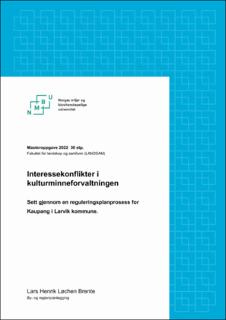| dc.contributor.advisor | Knut Bjørn Stokke | |
| dc.contributor.advisor | Thomas Haraldseid | |
| dc.contributor.author | Brente, Lars Henrik Løchen | |
| dc.date.accessioned | 2023-02-07T17:27:14Z | |
| dc.date.available | 2023-02-07T17:27:14Z | |
| dc.date.issued | 2022 | |
| dc.identifier | no.nmbu:wiseflow:6726303:52487189 | |
| dc.identifier.uri | https://hdl.handle.net/11250/3049044 | |
| dc.description.abstract | Det ligger en interesseavveining i møtet mellom verdiskapning gjennom bruk og bevaring av kulturminner- og kulturmiljøer. Med vide definisjoner av hva som kan defineres som kulturminner og ulike synspunkter knyttet til hvordan disse kulturminnene best skal forvaltes er kulturminnefeltet utsatt for interessekonflikter. Det gjelder både internt i kulturminneforvaltningen og der vernet av kulturminner kommer i konflikt med andre hensyn. I denne avhandlingen undersøkes det hvordan balansen mellom hensynene til verdiskapning/bruk og bevaring er ivaretatt i en sak der Riksantikvaren har involvert seg i en kommunal områdereguleringsprosess. Kaupang er regnet som Norges første by, og restene etter byanlegget på Kaupang ligger under bakken og er automatisk fredet etter kulturminneloven § 4. Gjennom en casestudie av planprosessen og omstendighetene rundt Områdeplan for Kaupang fornminneområde belyser oppgaven noen av hensynene som er vektlagt og forfektet av de ulike involverte aktørene.
Gjennom dokumentstudier og intervjuer med ulike involverte og interesserte aktører søkes besvart hvordan planprosessens forløp har artet seg, aktørenes synspunkter og verdigrunnlag, og hvordan de ulike aktørene har samarbeidet underveis. Funnene indikerer at det internt i kulturminneforvaltningen eksisterer ulike syn på hvordan Kaupang fornminneområde best skal forvaltes. Det har i tilfellet som er undersøkt vist seg at det foreligger ulike verdigrunnlag og interesser hos Vestfold og Telemark fylkeskommune og Riksantikvaren. Det kommer også frem at områderegulering etter plan- og bygningsloven § 12-2 fremstår som et godt virkemiddel der slike ulike hensyn skal balanseres. Planprosessen har allikevel blitt påvirket av de systemiske omstendighetene som hører med i kulturminneforvaltningen og i arealplanleggingen gjennom innsigelse etter plan- og bygningsloven.
Samlet sett viser oppgaven at formidlingshensynet har måttet vike for bevaringshensynet, og at dette er et resultat av flere kompliserende faktorer. I hovedsak synes det å være følge av kulturminneforvaltningens oppbygning, og at det er en sterk statlig aktør som prioriterer bevaring over formidling og verdiskapning på Kaupang i Larvik kommune. | |
| dc.description.abstract | There is a balancing of interests in the meeting between value creation through the use and preservation of cultural heritage. With broad definitions of what can be defined as cultural heritage and different viewpoints related to how this cultural heritage should best be managed, the field of cultural heritage is exposed to conflicts of interest. This applies both internally in cultural heritage management and where the protection of cultural heritage comes into conflict with other considerations. In this thesis, it is examined how considerations of use and the accompanying generation of value have been balanced against the consideration of conservation in a case where the Directorate for Cultural Heritage (Riksantikvaren) has become involved in a municipal area regulation process. Kaupang is considered to be Norway's first city, and the remains of the town complex at Kaupang lies under ground and are automatically protected under Section 4 of the Norwegian Cultural Heritage Act.
Through a case study of the planning process and the circumstances surrounding the Områdeplan for Kaupang fornminneområde, the thesis illuminates some of the considerations emphasized and advocated by the various actors involved. Through document studies and interviews with various involved and interested actors, answers are sought as to how the course of the planning process has unfolded, the actors' views and values, and how the various actors have cooperated along the way. The findings indicate that within the cultural heritage management there are different views on how the Kaupang ancient heritage area should best be managed. In the case investigated, it has been shown that there are different values and interests at Vestfold and Telemark County Council and the Directorate for Cultural Heritage (Riksantikvaren). It also emerges that area regulation according to Section 12-2 of the Norwegian Planning and Building Act appears to be a good instrument where such different considerations must be balanced. The planning process has nevertheless been influenced by the systemic circumstances that are part of cultural heritage management and spatial planning through objections to area plans under the Norwegian Planning and Building Act.
Overall, the thesis shows that considerations of use and the accompanying generation of value have had to give way to conservation considerations, and that this is a result of several complicating factors. It mainly seems to be a consequence of the structure of the cultural heritage management and that there is a strong state actor that prioritizes preservation over use through dissemination and the creation of values at Kaupang in Larvik municipality. | |
| dc.language | nob | |
| dc.publisher | Norwegian University of Life Sciences | |
| dc.title | Interessekonflikter i kulturminneforvaltningen - sett gjennom en reguleringsplanprosess for Kaupang i Larvik kommune. | |
| dc.type | Master thesis | |
